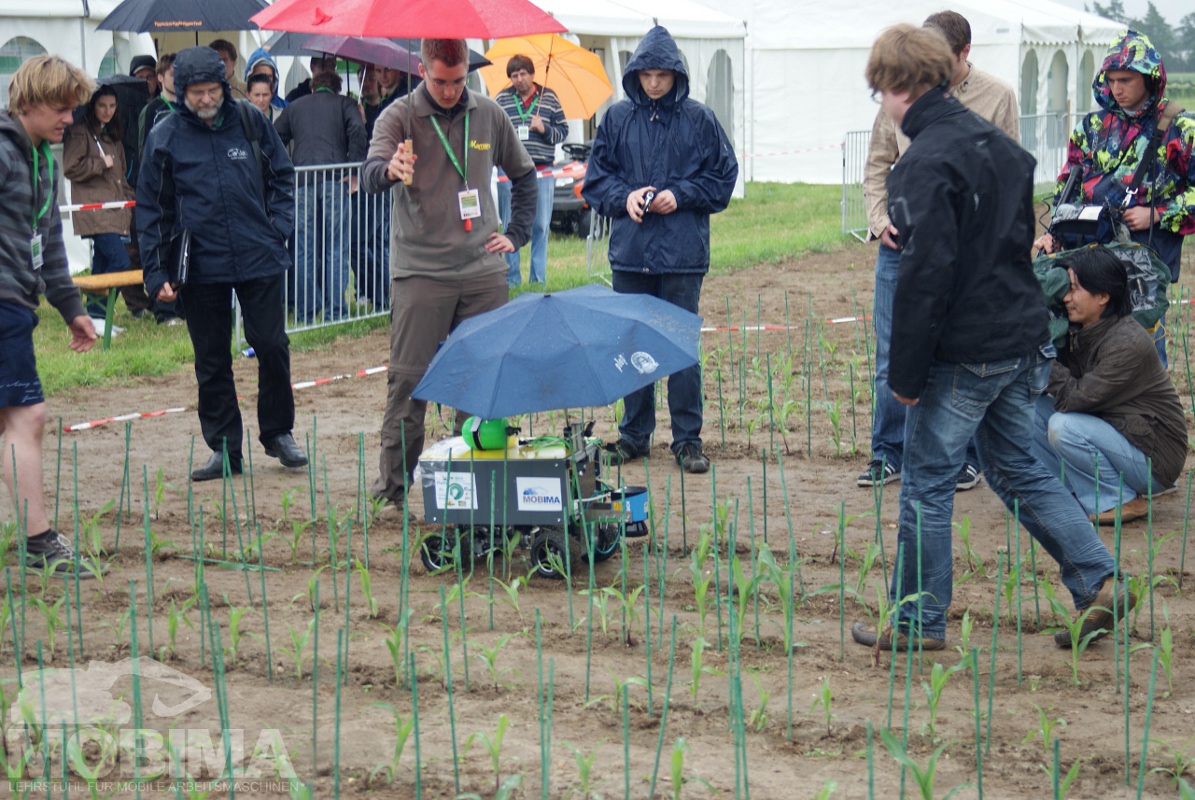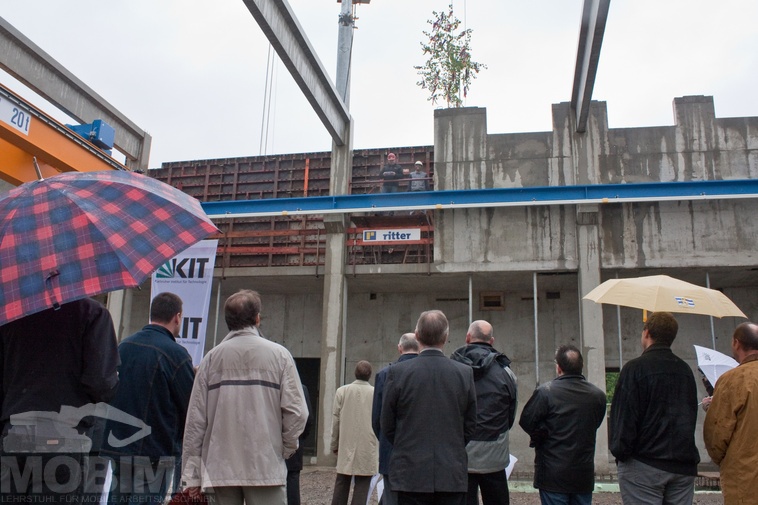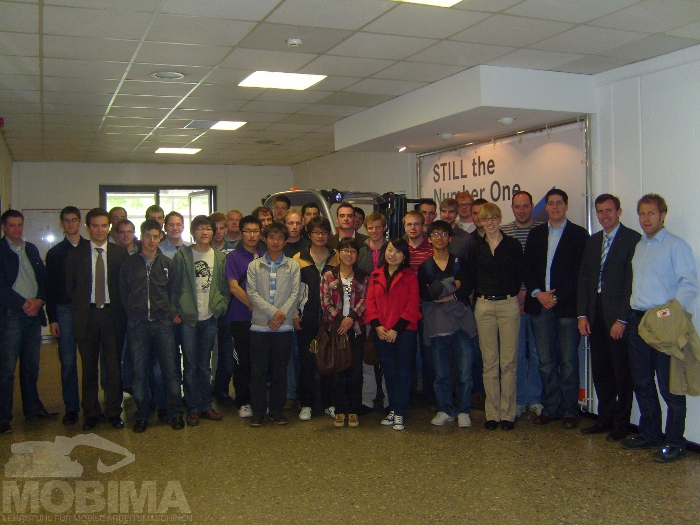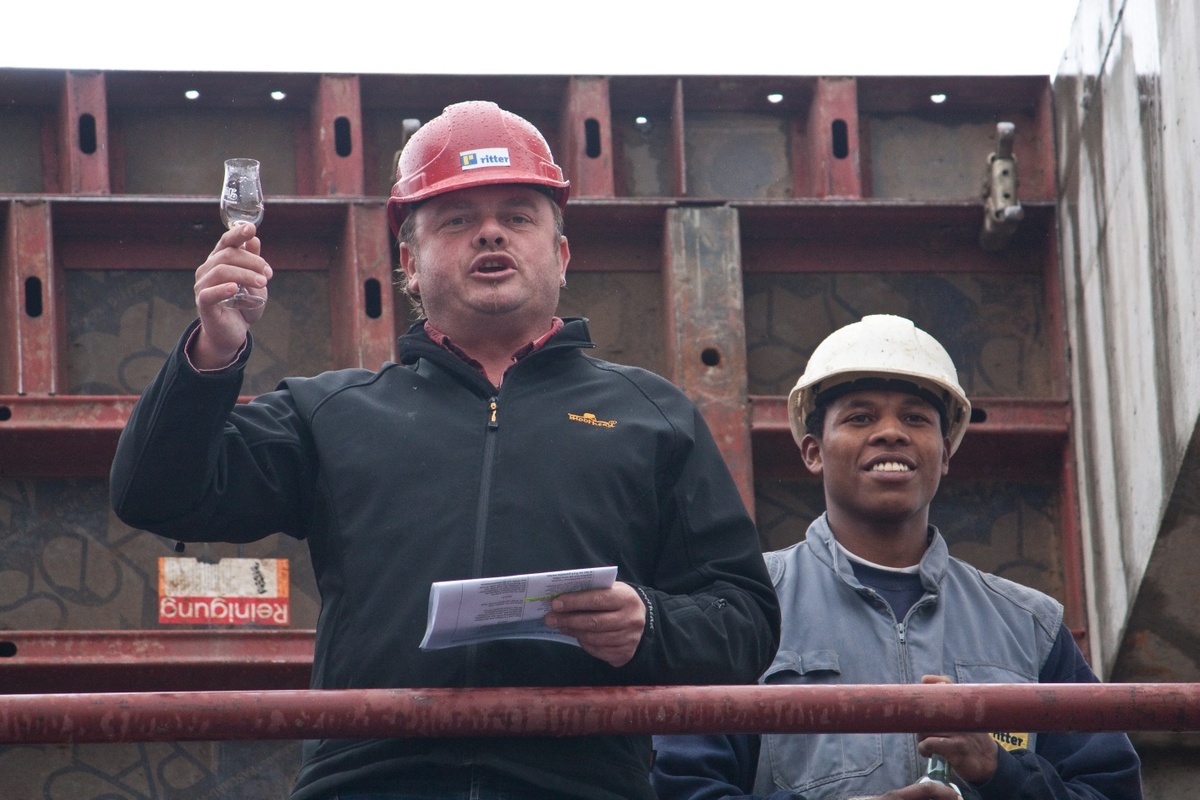Rain baptism of the KaMaRo 1 - The 8th FieldRobot event

The eighth international FieldRobotEvent, the world championship of autonomous field robots, was the premiere for the KaMaRo team from Karlsruhe. After attending the FieldRobotEvent in Wageningen last year, the student university group from the Karlsruhe Institute of Technology entered their own robot this year. But before this could happen, there were still a few hurdles to overcome.
Friday
After a smooth arrival on Friday, the 14 members of the team found a perfectly organized competition area. The only thing that had to be improvised thanks to the cold and rainy month of May -->was the corn plants. These were only 10 cm tall and had to be marked with green sticks for the robots.
Most of the 20 registered teams from seven nations drove the first test tracks on Friday. Unfortunately, KaMaRo 1 was still plagued by persistent technical problems in the form of a steering system that did not function as planned. The steering servo could not be configured as desired and the start of the KaMaRo 1 was in doubt. However, thanks to the support of last year's winning team from Braunschweig, the problem was resolved. The team tried until late into the night to get KaMaRo 1 ready to drive, but this was repeatedly delayed by communication problems between the modules and necessary adjustments to the mechanics.
Saturday
When the robot set off for the first time, the morning of the competition had already begun. Unfortunately, problems with navigation and WLAN access increased during the morning.
At 12:30, the robots were brought into a closed area by the jury and the competition began with the first task "Basic Navigation". This involves crossing rows of corn without errors and moving on to the next row. Team KaMaRo was allocated the last starting position in this discipline. Unfortunately, it started to rain in the second third of the first task, which required quick action. Without further ado, sensitive sensor technology was taped up for protection and an umbrella was mounted on the robot.
Due to the difficult conditions and the lack of experience in setting the navigation parameters, the run had to be ended after 6.80m. As no further changes could be made to the robot according to the rules, participation in the other navigation tasks had to be canceled.
However, image recognition could be presented in the freestyle task.
The day ended with many interesting conversations at the barbecue and the subsequent party.
Sunday
The FieldRobot Junior Event for school teams took place on Sunday. The winning teams also presented their robots and concepts.
Overall, the Karlsruhe team was able to gain a lot of important experience. In addition, the very open-minded field of participants facilitated lively exchanges and new contacts.
The declared aim for the 2011 competition in Denmark is to compete in all categories and complete them successfully.
Excursion 2010 - Visiting Still, Sauer-Danfoss and Bosch-Rexroth

As part of the 2010 excursion week, a total of 30 students and staff from the Chair of Mobile Machinery spent three days in Hamburg and the surrounding area. The highlights of the excursion were visits to the companies Still, Sauer-Danfoss and, on the way home, Bosch-Rexroth in Hanover. But the supporting program, which focused on the sights and culture of Hamburg, also contributed to an interesting and entertaining few days. The companies gave us an extremely friendly welcome and, in addition to insights into three highly interesting companies, the students were able to find out about internships, student research projects and dissertations and career entry opportunities. We would like to thank Ms. Reher (Still), Ms. Wittmann and Mr. Skirde (Sauer-Danfoss) and Mr. Hollmann (Bosch-Rexroth) for their excellent support. Of course, we were also well catered for, for which we would like to express our sincere thanks.
Special thanks also go to Dr. Schuhmacher (Sauer-Danfoss), who took the time to show us around Hamburg in person. On the first evening, we were able to get a first impression of the city with an excellent guided tour and an impressive view from the tower of St. Michael's Church. We would also like to take this opportunity to thank the WVMA for financing an exciting bus tour of the port and other program items.
Topping-out ceremony for "Vehicle Systems Technology" laboratory building

On the site of the former Mackensen barracks in Karlsruhe, the new "Interdisciplinary Vehicle Systems Technology" research building is currently being built, providing the necessary infrastructure for expanding the research work of the Institute of Vehicle Systems Technology at KIT. This creates the prerequisites for developing methodological and technological foundations for vehicles of the future in cooperation with the KIT focus area Mobility Systems and the KIT-CART competencecenter.
Helping to shape the mobility of the future is the goal of the research work at the Institute of Vehicle Systems Engineering and the interfaculty competence center KIT-CART, Center of Automotive Research and Technology, which it coordinates. As the innovation portal of the KIT focus area Mobility Systems, KIT-CART develops methodological and technological foundations and concentrates on land-based vehicles such as passenger cars, commercial vehicles, mobile machinery and rail vehicles with a focus on energy efficiency and emission reduction, driving and work safety, drivability and user-friendliness.
With the new research building "Interdisciplinary Vehicle Systems Technology", the infrastructure required for this research work is currently being created on the site of the former Mackensen barracks in Karlsruhe. "The research building and the testing facilities installed in it offer us the best conditions for helping to shape the vehicles of the future," says Professor Frank Gauterin, spokesman for the institute's management.
The shell of the new building for the research and testing facilities of the Institute of Vehicle Systems Engineering at KIT has been completed after a construction period of 6 months. The topping-out ceremony for the test hall with a usable area of around 2100 m² was celebrated on May 20, 2010. The construction work will be completed by the end of the year. This will pave the way for the all-wheel acoustic roller test bench, the vibration test field, the machine beds, the commercial vehicle lifting platform, the x-dynodrive test bench and the further expansion of a large internal drum test bench for tire/road tests to be operational from spring 2011, assured Ltd. Baudirektor Günter Bachmann from Vermögen und Bau Baden-Württemberg assured at a press conference at the construction site.
Under the project concept and control of the Karlsruhe office of the state enterprise, the reinforced concrete construction was built in strict compliance with the costs and deadlines. The successful planning by the architects Dömges from Regensburg, the construction management by Wacker and Jungmann from Karlsruhe and the construction work by the company Ritter from Schutterwald were further guarantees of the successful construction work to date.
The new building is being financed by the federal government and KIT with a cost volume of GBK = € 8,000,000, half each. In addition, €2,340,000 will be made available for large-scale equipment for the testing facility and an additional €3,400,000 from the Excellence Initiative.
From November, the complex testing equipment will be installed in the building, thus creating the infrastructural conditions for mobility research: this requires the possibility of controlled driving in the laboratory on a roller test bench as well as experimental simulation options for static and dynamic loads using servo-hydraulic and electro-dynamic actuators. Not only the vehicles, but also the driver and passengers are exposed to defined conditions. The aim of the work is in particular to analyze the interaction between vehicle, driver, infrastructure, traffic and society, to assess future developments and to derive new vehicle concepts from this.
The planned all-wheel acoustic roller test bench will be unique due to its design for testing a wide variety of land vehicles, from passenger cars to light and heavy trucks to agricultural and construction machinery with a total weight of up to 40 tons, especially as it can also be used to test wheelsets for rail vehicles. With this type of test bench, the wheels of the tested vehicle roll on large, individually adjustable drums, simulating driving on a road or rail. The test bench is used, among other things, for energy flow analyses during various driving and work cycles as well as for acoustic tests. For this purpose, an acoustic lining of the test room is planned.
Landesbetrieb Vermögen und Bau Baden-Württemberg performs all real estate, building and construction management tasks for the state-owned buildings. In this context, the Karlsruhe office is responsible for KIT's construction measures.
The Karlsruhe Institute of Technology (KIT) is a public corporation and state institution of the state of Baden-Württemberg. It fulfills both the mission of a university and the mission of a national research center in the Helmholtz Association. The KIT combines the tasks of research - teaching - innovation in a knowledge triangle.
Further information can also be found on the website of the Landesbetrieb Vermögen und Bau Baden-Württemberg, Amt Karlsruhe : http://www.vba-karlsruhe.de/







